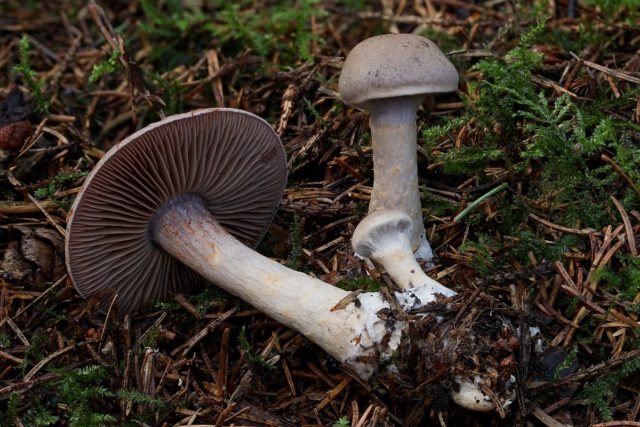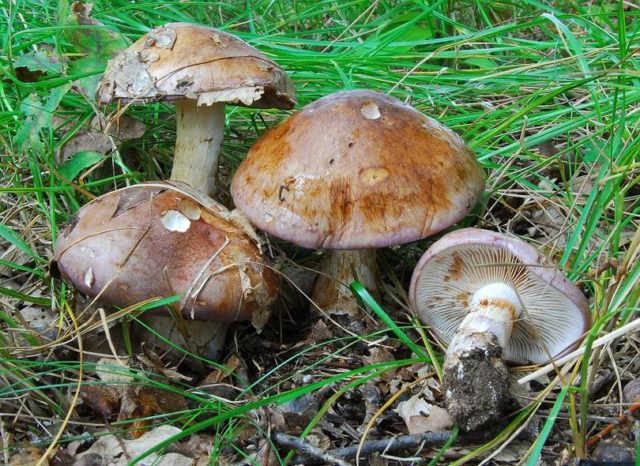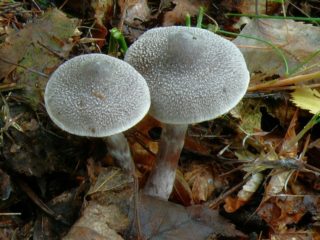Content
The anomalous or unusual cobweb is one of the representatives of the Cobweb family. Grows in small groups or singly. This species received its name, like all its closest relatives, thanks to the veil-like transparent web that is present along the edge of the cap and on the stem.It is especially noticeable on young specimens, and in adult mushrooms it is only partially preserved. In mycologist reference books, this mushroom can be found as Cortinarius anomalus.
What does an anomalous cobweb look like?

The spider web (cortina), characteristic of this species, has a purple tint
The fruit body has a classic shape. This means that its cap and leg have clear outlines and boundaries. But in order to be able to distinguish the anomalous cobweb from other species, you need to study in more detail the features and its external characteristics.
Description of the cap
The upper part of the anomalous cobweb initially has the shape of a cone, but as it matures it flattens and the edges become curved. Its surface is dry and silky smooth to the touch. At a young age, its main color is gray with a brown tint, and the edges have a purple tint. In mature specimens, the color of the cap changes and becomes red-brown.
The diameter of the upper part of the anomalous cobweb is 4-7 cm. When broken, the flesh has a whitish tint without a characteristic mushroom smell.

The consistency of the cap is watery and loose
On its inner side you can see a lamellar hymenophore. In young specimens it is gray-lilac in color, and later acquires a brownish-rusty color. The plates of the anomalous cobweb are wide and frequently spaced. They grow to the stem like a tooth.
The spores have a broad oval shape, pointed at one end. Their surface is completely covered with small warts. The color is light yellow, and the size is 8-10×6-7 microns.
Description of the leg
The lower part of the mushroom is cylindrical. Its length is 10-11 cm, and its thickness is 0.8-1.0 cm. At the base, the leg thickens and forms a small tuber. Its surface is smooth and velvety.The main shade is gray-fawn or white-ocher, but closer to the top it changes to grayish-blue.

In young specimens, the stem has a dense consistency, but as it matures, voids form inside it
Where and how does it grow
All spider webs prefer to grow in moss in wetlands. And this species can also develop on a litter of pine needles and foliage and directly in natural soil. Because of this feature, it received its name “anomalous” - because it grows in unusual places for cobwebs.
This species can be found in temperate climate zones, in coniferous and deciduous plantings. The fruiting period is from August to September.
The anomalous cobweb can be found in Western and Eastern Europe, as well as in Morocco, the USA and the island of Greenland.
In Russia, cases of finds have been recorded in the following areas:
- Chelyabinsk;
- Irkutsk;
- Yaroslavl;
- Tverskoy;
- Amurskaya.
The mushroom is also found in Karelia, Primorsky and Krasnodar regions.
Is the mushroom edible or not?
The anomalous cobweb is considered an inedible species. No special research has been conducted in this area, so it is impossible to speak more specifically about the degree of danger. But in order to avoid possible health complications, eating even a small piece of this mushroom is strictly prohibited.
Doubles and their differences
Adult specimens of the anomalous web spider are difficult to confuse with other species. And at an early stage this is quite possible.
Existing twins:
- Cobweb or changing. Inedible representative of the general family.Its upper part is initially hemispherical, and later becomes convex. The color of the fruiting body in young specimens is light purple, and when ripe it changes to red-brown. The official name is Cortinarius nemorensis.
With high air humidity, the cap of the oak spiderwort becomes covered with mucus
- Spider web cinnamon or dark brown. An inedible double, the cap of which is initially hemispherical and then prostrate. The color of the fruiting body is yellowish-brown. The stem is cylindrical; in young mushrooms it is solid, and then becomes hollow. The pulp has a light yellow tint. The official name is Cortinarius cinnamomeus.
The pulp of the cinnamon spider web has a fibrous structure
Conclusion
The anomalous cobweb is not of particular interest to experienced lovers of quiet hunting, as it is an inedible species. Therefore, when collecting, beginners need to be especially careful so that this mushroom does not accidentally end up in the general basket. Eating it even in small quantities can cause serious health complications.










